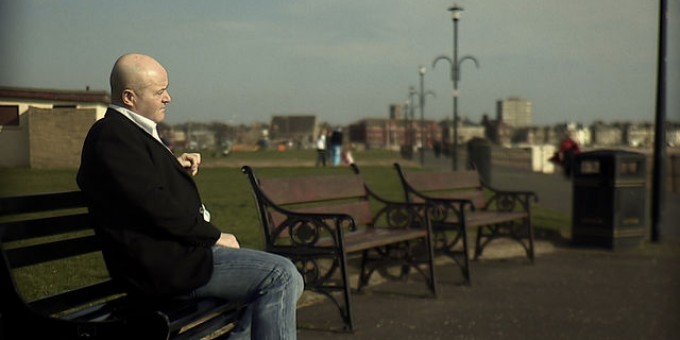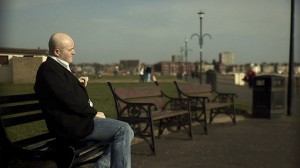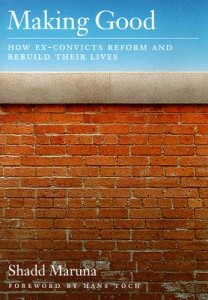
Shadd Maruna and Fergus McNeill have spent the better part of their careers asking questions about “desistance”: why and how people transition out of crime. As their work has shown, desistance is a tricky concept to define and measure. While some think of it as a permanent cessation of criminal behavior over several years, others use a more fluid definition that accepts that episodes of re-offending may occur. Either way, desistance is a positive outcome for individuals and for society as a whole, as it involves long-term abstinence from crime among those with a history of serious criminal behavior.
In their latest project, the two scholars—along with Steve Farrall (at the University of Sheffield) and Claire Lightowler (of the Institute for Research and Innovation in Social Services)—collaborated with former prisoners to tell the story of desistance with those who are actively engaging in the process. Their documentary film, The Road from Crime, is a “co-production” with Allan Weaver, a Scottish “ex-offender” turned probation officer (and author of the book So You Think You Know Me?) documenting his journey to understand his own process of desistance and those of others like him. In merging social science research insights with firsthand experience, the collaboration delivers a fresh perspective on desistance through film.The documentary was produced as part of the larger Discovering Desistance project, which aims to share knowledge and improve understanding of why people desist from crime.
In a podcast interview with TSP’s Sarah Lageson, Maruna and McNeill talked about why they went from writing books and articles about desistance to making films.
Maruna: The academic lecture is a classic, it’s what keeps us in business at some level, but it’s not necessarily the best way to convey information (think how many lectures we’ve all slept through in the past!). We thought bringing the subject a bit to life, as you can do on film, would be a better strategy at some level. Film can put a human face on desistence (in this case, several faces come out). It brings something important that books and the articles can’t—when you can look into somebody’s eyes and see them as a fellow human.
This article is also something of a co-production. In addition to speaking with these experts, we dug deeply into their academic writings and materials specially created for the film. To faithfully present this vision of desistance, we draw directly from each of these sources, as well as our interview with Maruna and McNeill. For example, both Weaver’s journey and the goals of the collaboration are introduced on the film’s website:
In our documentary, The Road from Crime, Allan Weaver asks a simple question: What can we learn from those former prisoners who have successfully “desisted” from criminal behavior or “gone straight?” Starting where it all began for him on the streets of his hometown and in Barlinnie Prison in Glasgow, Allan sets off to understand how individuals like himself get caught up in cycles of crime and punishment, and how they break out of these patterns and move on to new lives. This journey takes him across the UK, meeting an array of ex-prisoners and ex-prisoner activist groups, probation leaders, and criminological experts from London to Washington, DC.

One of the biggest hurdles for former prisoners is what sociologist Erving Goffman called “stigma”—overcoming the simple fact of being a former prisoner. Following Weaver’s journey, the vicious cycle becomes clear: crime leads to contact with the criminal justice system, which can result in even more crime through labeling and stigmatization. Criminologists have focused so much on the problem of “recidivism” or returning to crime, however, that the success stories of desistance remain largely untold. As The Road from Crime website puts it:
The exit at the prison gate often appears to be a revolving door with nearly 60 per cent of released prisoners re-offending within two years of their release. Prisons and probation departments have, almost literally, tried everything in efforts to rehabilitate offenders over the past century, but the results have been uniformly bleak, leading many to conclude that “nothing works.” In the past ten years, however, a group of criminologists have hit upon what should have been an obvious source of inspiration for prisoner rehabilitation: the other 40%!
The upsurge of interest in the other 40%—from scholars, practitioners, and policymakers around the world—is partly driven by budget concerns and the high costs of criminal punishment. If the criminal justice system could more effectively hasten the transition from offender to former offender, there is much to be gained. We would not only save the money it would cost to reincarcerate repeat offenders but we would also reap the benefits of their productive contributions—in the taxes they pay, the families they support, and the positive roles they could play in their communities.
Every desistance story is different, but most tend to involve both external support from others and internal change and self-discovery. The film shows ex-prisoners speaking directly about the people who believed in them when others had lost hope and about rediscovering their self-worth—realizing that they too had something to offer others, especially, for many, their own children.
Defining Desistance
Countless studies have asked what causes people to start committing crime, but far fewer have asked why people stop. Reading the paper “How and Why People Stop Offending: Discovering Desistance” by McNeill, Lightowler, Farrall, and Maruna, we learn that the “age-crime” curve is one of the few near certainties in criminal justice. For most people, crime peaks in the teenage years, and then declines quickly thereafter. But why and how they desist is not well known, even though it is one of the key outcomes that the criminal justice is supposed to achieve.
Early desistance theories from criminologists like Sheldon and Eleanor Glueck focused on “maturational reform”—a natural process linked to aging. Although age is one of the best predictors of desistance, aging involves a great range of processes, including biological changes, social transitions, and life experiences. For age to be a meaningful explanation of desistance, we need to ask what it is about aging that makes a difference.For the past two decades, sociologist Robert Sampson and John Laub, former Director of the National Institute of Justice, theorized that committing crime is more likely when the bond between an individual and society is weakened or broken. They argue that at various points of the lifecourse, formal and informal social institutions help to solidify the bond between the individual and society and reduce criminal behavior. For adolescents, schools, families, and peer groups influence the bond between young people and the broader community. For adults, employment, marriage, and parenthood operate in a similar way. Key events or “turning points” (like a new job opportunity) can trigger changes in an individual’s bond to society and influence crime and desistance patterns.
Sampson and Laub’s work has been dominant since the 1990s, though it has been challenged by criminologists like Michael Gottfredson and Travis Hirschi. They contend that life events like marriage and employment are themselves governed by a trait they call self-control, which crystallizes in early childhood. Psychologist Terrie Moffitt argues that there are really two types of criminal offenders. The first are “adolescence-limited” who start to offend in early adolescence and cease offending relatively soon afterwards. The second are “life-course persistent” who start much earlier and continue to commit crime well past their teenage years.
These latter approaches perhaps don’t seem to leave much room for interventions that would hasten desistance among those with “low self-control” or “life-course persistent” offending patterns. Maruna and McNeill are more optimistic, emphasizing the importance of self-concept and identity—as well as of social support. Maruna has found that to desist from crime, people need to develop “a coherent, pro-social identity for themselves.” This happens when they see themselves in control of their futures and have a clear sense of purpose and meaning in their lives. Desisters also find a way to make sense of their past lives and find some redeeming value in the time spent in the criminal justice system. The ex-prisoners Maruna interviewed often said they wanted to put these experiences “to good use” by helping young people in similar circumstances to their own avoid the mistakes they had made. Sociologists Peggy Giordano and colleagues describe a similar process in their four-part “theory of cognitive transformation” where they argue that the desistance process involve a “general cognitive openness to change,” exposure and reaction to “hooks for change” or turning points, envisioning an appealing and conventional “replacement self,” and a transformation in how deviant behavior is viewed.Maruna and Thomas LeBel, in their chapter “The Desistance Paradigm in Correctional Practice: From Programs to Lives,” also see an important role for “delabelling”, in which positive behavior change is recognized by others and reflected back to the desister. They argue that people start to believe that they can successfully change their lives when those around them demonstrate that they also believe change is possible. Put another way, not only must a person accept conventional society to go straight, but conventional society must recognize and accept that this person has changed as well.
The researchers point out that focusing on desistance from crime moves us away from ideas of people as “offenders,”“criminals,” or “prisoners” and encourages us to think about how these statuses change over time. In fact, today’s “young offender” is more likely to become tomorrow’s “new father” than tomorrow’s “habitual criminal.” This means valuing people for who they are and for what they could become, rather than judging them for what they have done. To really improve criminal justice efforts to help people desist from crime and find their way to reintegration, we’ll need insights from desisters like Weaver as well as social scientists.
Filming Desistance
We asked Maruna and McNeill how they got involved in making The Road From Crime and why they wanted to tell the desistance story in film.
What’s different about telling a research story in a film, rather than in other media?
Maruna: We found out there are many parallels between the way we do research and the way documentary experts make films. If you think about all the difficulties of doing qualitative research, you’ve got to magnify them by 10- or 20-fold when you add the cameras and so forth. We always have technological glitches when you’re doing interviews—your digital recorder won’t work or you’ve run out of battery or these things—well, when you’ve got the sound boom, the camera, the lights, something always is going wrong! The easiest interview turned into an hour and a half, two hours in the field because of those technology problems with film.
McNeill: We wrote the voiceover together… several times and gave it to the director. And the director wrote back to us and said… and this is paraphrasing, “Why don’t you trust my film?” And the… obvious message was that in documentary filmmaking, you leave some of the responsibility, obviously, with the viewer to interpret what they’re seeing.
Are there different practical and ethical issues involved in making this sort of film?
Maruna: There are important ethical issues in qualitative research. It’s crucial to be able to protect people’s identities and to not expose people to risks of harm. All of that is magnified when you’re shining a camera at somebody and projecting their image online. The awkwardness of the interview becomes a lot more difficult when there are so many people involved, rather than just you and a tape recorder. But in terms of the actual process, it involves interviewing people, getting their narratives, and then the editing, which is really where all the hard work is. It was essentially doing an inductive analysis, just like for an academic article or a book.
 How did making the film unearth new research ideas?
How did making the film unearth new research ideas?
Maruna: Almost all of the major themes in the film can be found in Making Good or any of Fergus’s articles on the topic, but making the film did put some of those themes in a sharper focus. For example, the “contagion effect” of desistance, where two of the interviewees in Washington, D.C. are talking about, “I went straight because he went straight and I could see that was a road for me.” We heard that theme a number of other times from others, and in the research, but they came to life in the film.
McNeill: The approach that we took in the project overall was essentially one of co-production—so, we bring a certain kind of knowledge to the process, but we respect and value and want to enter into a dialog with other forms of knowledge (the knowledge of ex-offenders, the knowledge of family members and supporters, the knowledge of practitioners, of policy makers, and the knowledge of the artists, the creative artists involved in the filmmaking process). The whole ethos of the thing is to try to co-construct a narrative which has meaning and validity and some kind of truth amongst all of those parties. That’s what generates the kind of unique quality of the project’s outcomes. They are not just an academic reading of a social problem, delivered back to people in the field, people affected by the problem in question, they are something that we produced together.
The idea of co-producing knowledge is close to the heart of The Society Pages project, but can co-production really help develop effective policies to reduce crime among released prisoners?
McNeill: One major finding out of the project was not a substantive recommendation for criminal justice in any specific domain, but rather the idea that, if we want people to engage with justice processes in order that they might, in some way transform their lives and be supported towards integration in society, then it’s absurd to imagine that we can do that other than co-productively—other than by engaging with them, respecting them, their knowledge, their expertise, their lived experience. People are working hard at trying to change and address their problems, but if people in the community aren’t going to accept them back, then all that hard work is liable to be in vain.
Recommended Reading
Peggy C. Giordano, Stephen A. Cernkovich, and Jennifer L. Rudolph. 2002. “Gender, Crime, and Desistance: Toward a Theory of Cognitive Transformation,” American Journal of Sociology. 107(4): 990-1064. Develops a cognitive theory to explain desistance among serious female delinquents as well as their male counterparts.
Megan C. Kurlychek, Robert Brame, and Shawn D. Bushway. 2006. “Scarlet Letters and Recidivism: Does an Old Criminal Record Predict Future Offending?” Criminology & Public Policy. 5(3): 483-504. Shows that the risk of new crimes among those who have desisted for seven years is similar to the risk of new crimes among persons with no criminal record.
John H. Laub and Robert J. Sampson. 2003. Shared Beginnings, Divergent Lives: Delinquent Boys to Age 70. Cambridge, MA: Harvard University Press. A classic long-term study of desistance, following Boston men from adolescence to old age.
Shadd Maruna. 2001. Making Good: How Ex-Convicts Reform and Rebuild Their Lives. Washington, DC: American Psychological Association. A pathbreaking desistance study that focuses on narratives of personal change.
Fergus McNeill. 2006. “A Desistance Paradigm for Offender Management,” Criminology and Criminal Justice. 6(1): 39-62. A clear and powerful application of desistance theory to criminal justice practice.

Comments 1
Friday Roundup: March 22, 2013 » The Editors' Desk — April 1, 2014
[…] “Discovering Desistance,” by Sarah Shannon and Sarah Lageson. In which we learn what criminologists know about desistance and about how research changes when it’s on film. Features Shadd Maruna and Fergus McNeill. […]